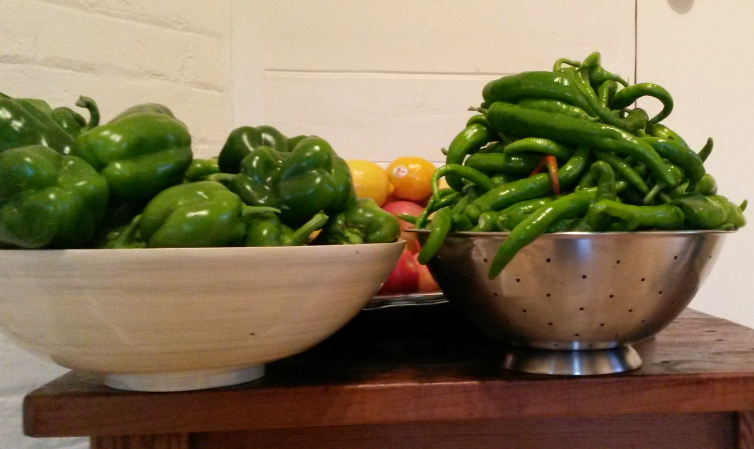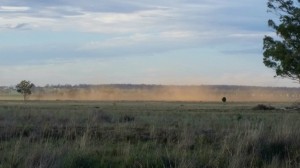It’s always great to get off the farm as I find I think in fresh ways and from a different perspective. Mix with this being surrounded by people equally as passionate about farming in a conscious manner and it’s a pretty good combination – as we found at Acres USA. I will share with you some detail of practices and growers techniques in time, but today I want to discuss where our food producing systems have gone wrong and that this creates opportunities for us as growers.
I am always aware of how our crop and livestock production systems affect the quality of soils, our animals and our food and, in turn, the health of us and our families. After all, this is one of the reasons we changed the way we do things on our farm. With young children, I wanted them to live in a safe, clean environment and I wanted to produce a product that is safe to consume. As well as chemical free, I want to produce a mineral dense food that nourishes our bodies.
Despite being well aware of the problems with conventional production systems and the associated health problems, (and even changing our practices accordingly), I am still shocked as to the seriousness of this problem when I hear people like Don Huber of Purdue University speak. Don shared the science behind why we should be concerned about the impacts of Glyphosate and GMO’s on the health of our soils, plants, animals and ourselves.
GMO’s and Glyphosate
“The importance of herbicides is in immobilizing a critical nutrient for a specific enzymatic function”1. They immobilise these nutrients by chelating them – “a chelating agent means it’s molecule wraps around the molecules of other elements (like manganese, iron, zinc) making them unavailable to the plant”2. Selective herbicides work on a specific nutrient – for example, the phenoxyprop group are chelators of copper. Glyphosate however, is a chelator of not only one nutrient, but of all cations, which is why it has a broad spectrum activity on plants. (“There are 291 known enzymes inhibited by glyphosate”3). So, Doctor Huber is saying that the use of glyphosate – especially in Roundup Ready GM crops where glyphosate is applied over the top of the crop and often with increased frequency, nutrient deficiencies in the plant begin to show up, due to their immobilisation by chelation. This can be offet by foliar nutrient applications, but this is still not getting to the root cause of the problem.
There are also indirect effects of glyphosate on plants through soil biology. Glyphosate affects element reducing microbes in the soil that make certain elements available to the plant. In the case of glyphosate treated genetically modified (GM) crops, the plants take in the glyphosate, exude plant sugars into the soil, taking with them the glyphosate molecule and in turn reducing soil microbe populations which are responsible for making micronutrients available to the plants.
There is lots more detail I want to share on this, but I will leave that for a blog of its own in order to best explain it, but in short, the outcomes of repeated glyphosate use are:
- increased rates of plant diseases due to missing soil biology that provide the necessary micronutrients to plants which enable their natural defence mechanisms to work.
- an increase in plant pathogens as the soil microbiology is out of balance and an increased rate of plant diseases, such as fusarium head blight. I know if I think of my area, there is much increased use of fungicides in cereal crops compared with when I was working as an agronomist in conventional systems 15 years ago.
- decreased nutrient density in the crop outputs.
Dr Huber has much quantified evidence of the above mentioned things.
Dr Huber explained that because glyphosate is a chelating agent, it chelates with calcium in the soil and affects soil structure. The soil particles align in a sideways lattice structure rather than vertically, which affects the soil’s infiltration and aggregation.4 Soil structure and moisture infiltration are also impacted negatively by the decreased soil microbiology.
It was really dry when Derek and I left home to go to the conference – but while we were away, we had great rain and more after arrived home, which we were delighted about. We had a total of 75mm (3 inches) of rain over about 6 days. The final falls came with 12mm (48points) on Tuesday afternoon and then another 10mm (40points) that night. It had been excessively dry prior to this rain, so I was amazed to see that there was significant amounts of runoff from neighbouring paddocks. Not only this, but this same paddock, by Wednesday afternoon (not 24 hours after the rain finished) there was dust blowing off the same country! I wouldn’t have believed it myself if I hadn’t seen it myself.
From a distance…
There is clearly something really wrong with our farming system if we can’t infiltrate around 3 inches of rain after a long dry spell, and then we have dust blowing off the same country by the next day! Something needs to change.
I don’t mention this to criticize the neighbour, but to point out the shortcomings of the system and in a dry continent like Australia, rainfall is so precious and we want to capture every drop that falls. We are all at different stages of awareness and place varying importance on different values.
Antibiotics
Something I was also aware of but am constantly astounded by the figures associated with it, is the effects of the use of antibiotics in intensive feed systems. The film ‘Resistance’ shed light on this – 80% of the antibiotics sold in the U.S. in 2011 were used on farms! That’s right, as well as therapeutic use, there is low rate inclusion of antibiotics in animal feed for improved conversion of feed as well as increased growth rates and lower mortality. The effects of which however, is the retention of resistant strains of bacteria, which proliferate in these animals. This can be spread to humans through contact with animal manure, intestines (in abattoirs) and by consuming the meat, as cooking the meat does not always kill all bacteria. Such practices can lead to the occurrence of superbugs that cannot be controlled by any antibiotic family.
Given that 90% of the meat consumed in America comes from CAFOs (concentrated animal feeding operations), where this practice is used, this is a major concern. ‘Resistance’ reported that 147,000 Americans die of uncontrollable infections each year…let me run that number by you again, 147,000! Of the antibiotics used in CAFO’s, 80% of them are not therapeutic – but rather low dose continual use in stock feeds of cattle, chooks (chickens), turkeys, pigs etc.
This is without mentioning the antibiotic impacts on gut flora which is essential to our health and affects our general wellbeing and digestive ability. When we realise the importance of gut function for optimal brain function, then we start seriously looking at the food we eat.
Effects on Human health
Dr Mercola, well known alternative health doctor of the U.S. shared many disturbing facts about the health of our populations, which are reflective of the above mentioned things, as well as processed foods, poor food choices and the stresses in our lives.
- 1 in 10 of all Americans take antidepressants
- If you consider women over 55, then it is 1 in 4
- When Dr Mercola started medical school, 1 in 10,000 American children were diagnosed with autism. This is now 1 in 50, and if it increases at the current rate, it will be 1 in 2 by 2025!
- and so on… obesity, heart disease, diabetes, infertility rates, etc
As farmers there is opportunity in this for us. I see a common thread among practitioners like Dr Mercola, who are moving away from lots of mineral and vitamin supplements as health cures, and concentrating more on healthy, nourishing, GMO free, antibiotic free, organically produced, nutrient dense, whole foods.
This is where the awesome opportunity is for us as farmers. We can help educate and provide these foods for increasing the health of our communities. This food will be more and more sought after as people have the realization that you and I already have about good food. Surely, we owe it to ourselves to produce and consume healthy, nourishing food that is fit to help us thrive.
Franklin Rossevelt stated ‘A nation that destroys its soil, destroys itself”. So true. This is why regenerative agriculture is so important; let’s choose practices that actually build our soils. It can be done. Give me a call if you want to discuss – 0417 894 474
ps. We got to talk with Joel Salatin, Gabe Brown, Mark Shephard, and many more. Also loved sharing stories with everyday farmers and hearing what they are doing.
References
1 & 3,4. Huber, D. Acres Conference.
2 Halbeisen, J. Glyphosate and Micronutrients. http://www.growersmineral.com/crops/indepth-articles/glyphosate-and-micronutrients 13th Dec ’14.



